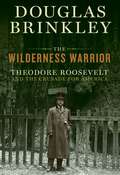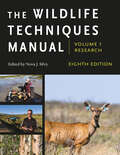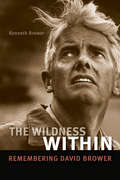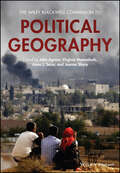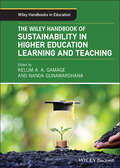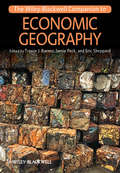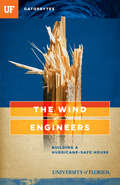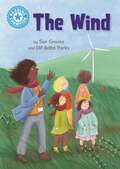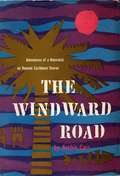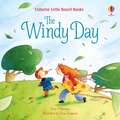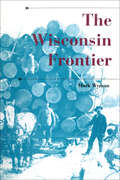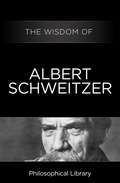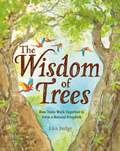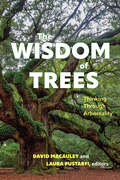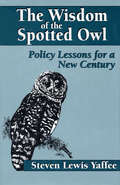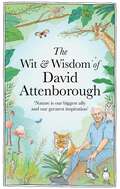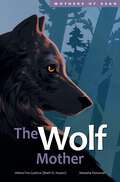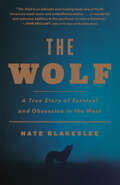- Table View
- List View
The Wilderness Warrior: Theodore Roosevelt and the Crusade for America
by Douglas Brinkley<P>In this groundbreaking epic biography, Douglas Brinkley draws on never-before-published materials to examine the life and achievements of our "naturalist president." <P>By setting aside more than 230 million acres of wild America for posterity between 1901 and 1909, Theodore Roosevelt made conservation a universal endeavor. This crusade for the American wilderness was perhaps the greatest U.S. presidential initiative between the Civil War and World War I. Roosevelt's most important legacies led to the creation of the U.S. Fish and Wildlife Service and passage of the Antiquities Act in 1906. His executive orders saved such treasures as Devils Tower, the Grand Canyon, and the Petrified Forest. <P>Tracing the role that nature played in Roosevelt's storied career, Brinkley brilliantly analyzes the influence that the works of John James Audubon and Charles Darwin had on the young man who would become our twenty-sixth president. With descriptive flair, the author illuminates Roosevelt's bird watching in the Adirondacks, wildlife obsession in Yellowstone, hikes in the Blue Ridge Mountains, ranching in the Dakota Territory, hunting in the Big Horn Mountains, and outdoor romps through Idaho and Wyoming. <P>He also profiles Roosevelt's incredible circle of naturalist friends, including the Catskills poet John Burroughs, Boone and Crockett Club cofounder George Bird Grinnell, forestry zealot Gifford Pinchot, buffalo breeder William Hornaday, Sierra Club founder John Muir, U.S. Biological Survey wizard C. Hart Merriam, Oregon Audubon Society founder William L. Finley, and pelican protector Paul Kroegel, among many others. He brings to life hilarious anecdotes of wild-pig hunting in Texas and badger saving in Kansas, wolf catching in Oklahoma and grouse flushing in Iowa. Even the story of the teddy bear gets its definitive treatment. <P>Destined to become a classic, this extraordinary and timeless biography offers a penetrating and colorful look at Roosevelt's naturalist achievements, a legacy now more important than ever. Raising a Paul Revere-like alarm about American wildlife in peril--including buffalo, manatees, antelope, egrets, and elk--Roosevelt saved entire species from probable extinction. <P>As we face the problems of global warming, overpopulation, and sustainable land management, this imposing leader's stout resolution to protect our environment is an inspiration and a contemporary call to arms for us all. <P><b>A New York Times Bestseller</b>
The Wildlife Detectives: How Forensic Scientists Fight Crimes Against Nature
by Donna M. Jackson Wendy Shattil Bob RozinskiSlaughtering elephants for their ivory; shooting bears for their gall bladders; capturing sea turtles for soup. In the name of vanity, fashion, and greed, man stalks and kills wild animals -- and gets away with it, even when it is clearly against the law. But now scientists have a way to catch and convict poachers. In a laboratory in Ashland, Oregon, they analyze clues to link suspects to crimes. In words and pictures, this book tells a poignant story and reveals how science can indeed save the day.
The Wildlife Techniques Manual: Volume 1: Research. Volume 2: Management.
by Nova J. SilvyThe #1 selling wildlife management book for 40 years, now updated for the next generation of professionals and students.Since its original publication in 1960, The Wildlife Techniques Manual has remained the cornerstone text for the professional wildlife biologist. Now fully revised and updated, this eighth edition promises to be the most comprehensive resource on wildlife biology, conservation, and management for years to come.Superbly edited by Nova J. Silvy and published in association with The Wildlife Society, the 50 authoritative chapters included in this work provide a full synthesis of methods used in the field and laboratory. Chapter authors, all leading wildlife professionals, explain and critique traditional and new methodologies and offer thorough discussions of a wide range of relevant topics. To effectively incorporate the explosion of new information in the wildlife profession, this latest edition is logically organized into a 2-volume set: Volume 1 is devoted to research techniques and Volume 2 focuses on pragmatic management methodologies.Volume 1 describes research design and proper analytic methods prior to conducting research, as well as methods and considerations for capturing and handling wild animals and information on identification and marking of captured animals. It also includes new chapters on nutritional research and field sign identification, and on emerging topics, including structured decision-making. Finally, Volume 1 addresses measurements of wildlife abundance and habitat and research on individual animals.Volume 2 begins with a section on the relationship between research and management including public outreach, described in a context that encourages engagement prior to initiation of management. An adaptive management approach is described as a cornerstone of natural resource management, followed by a section on managing landscapes and wildlife populations. The volume also includes new chapters on ethics in wildlife science and conservation, conflict resolution and management, and land reclamation.A standard text in a variety of courses, the Techniques Manual, as it is commonly called, covers every aspect of modern wildlife management and provides practical information for applying the hundreds of methods described in its pages. This deft and thorough update ensures that The Wildlife Techniques Manual will remain an indispensable resource, one that professionals and students in wildlife biology, conservation, and management simply cannot do without.
The Wildness Within: Remembering David Brower
by Kenneth BrowerThe twentieth-century environmental movement owes much to a single man: David Brower. Countless natural wonders would have been lost if not for his efforts and the tremendous energy put forth by organizations he directed and/or founded (including the Sierra Club, Friends of the Earth, and the Earth Island Institute). A tireless defender of wild areas, Brower worked to protect iconic places, including the Grand Canyon and the California redwood forests, and his work and passion helped define modern environmentalism. For the hundredth anniversary of David Brower's birth, his son Kenneth Brower, an acclaimed nature writer, has brought together the testimonies of nineteen environmental leaders whose lives and careers were transformed by David Brower; the result is a book in which a repertory company of path-forgers reveal their deepest values and most moving experiences. Reading like an adventure novel told by the intrepid folks who rode alongside Brower, The Wildness Within presents illuminating anecdotes about a multifaceted man who changed the world, serving as a guide to young people and a bane to bureaucrats and others more cautious in their approach to the crises at hand. Contributors include: Paul Ehrlich, author of The Population Bomb Dave Foreman, founder of Earth First! Harold Gilliam, former San Francisco Chronicle environmental columnist Paul Hawken, founder of Smith and Hawken, and coauthor of Natural Capitalism Randall Hayes, founder of The Rainforest Action Network Huey Johnson, pioneer environmentalist and founder of the Trust for Public Land Amory Lovins, author of Reinventing Fire Nancy Skinner, coauthor of 50 Simple Things You Can Do to Save the Earth
The Wiley Blackwell Companion to Political Geography (Wiley Blackwell Companions to Geography)
by John Agnew Joanne Sharp Virginie Mamadouh Anna J. SecorThe Wiley Blackwell Companion to Political Geography aims to account for the intellectual and worldly developments that have taken place in and around political geography in the last 10 years. Bringing together established names in the field as well as new scholars, it highlights provocative theoretical and conceptual debates on political geography from a range of global perspectives. Discusses the latest developments and places increased emphasis on modes of thinking, contested key concepts, and on geopolitics, climate change and terrorism Explores the influence of the practice-based methods in geography and concepts including postcolonialism, feminist geographies, the notion of the Anthropocene, and new understandings of the role of non-human actors in networks of power Offers an accessible introduction to political geography for those in allied fields including political science, international relations, and sociology
The Wiley Blackwell Companion to Political Geography (Wiley Blackwell Companions to Geography)
by John Agnew Virginie Mamadouh Natalie Koch Chih Yuan WoonA vital resource for understanding how political geography engages with a rapidly transforming world The Wiley Blackwell Companion to Political Geography provides an expansive and up-to-date view of the dynamic and evolving field, seamlessly combining critical theoretical debates, empirical investigations, and practical applications. Edited and authored by leading experts from varied intellectual, geographic, and methodological perspectives, this comprehensive volume offers insights into foundational concepts such as power, territory, sovereignty, and nationalism while highlighting the latest global trends, cutting-edge research, and ongoing debates. Balancing continuity with innovation, the second edition of the Companion addresses recent intellectual advances and geopolitical developments, with wholly new coverage of peace, health water politics, climate change, ocean geographies, and much more. The contributing authors demonstrate how political geography remains deeply relevant, connecting long-established themes to the shifting landscapes of contemporary geopolitics. Throughout this edition, new and revised chapters illustrate how core concepts like scale, borders, nationalism, citizenship, and memory are shaped by and shape the world's political landscape. Equipping readers with the intellectual tools to investigate and interpret complex global phenomena, The Wiley Blackwell Companion to Political Geography: Offers novel perspectives on nonhuman actors, digitalization, climate change, and the impact of the Anthropocene on geopolitics Incorporates various interdisciplinary approaches, drawing insights from political science, sociology, and international relations Features in-depth discussions on feminist geographies, postcolonialism, and practice-based methods in geography Provides a unique organizational structure that blends conceptual analysis with practical insights across diverse scales Examines the intersection of materiality and politics, including environmental entanglements and human-material relationships Emphasizes the evolving nature of borders and citizenship in an increasingly interconnected world Organized into clearly defined sections that guide readers through foundational theories, processes, and applications, The Wiley Blackwell Companion to Political Geography, Second Edition is invaluable for students in upper-level undergraduate, master's degree, and PhD programs in political geography, political science, international relations, and related disciplines. It is also a key reference for scholars and practitioners looking for a reliable resource for understanding contemporary global issues.
The Wiley Handbook of Sustainability in Higher Education Learning and Teaching (Wiley Handbooks in Education)
by Kelum A. A. Gamage Nanda GunawardhanaA comprehensive resource for higher education professionals interested in sustainability pedagogy In The Wiley Handbook of Sustainability in Higher Education Learning and Teaching, a team of distinguished researchers delivers an insightful reference for higher education professionals seeking to embed sustainability in learning and teaching. The book offers a way for higher education institutions to implement sustainability goals in their curricula and provides comprehensive guidance to educators, researchers and practitioners. The authors discuss recent developments in technological innovations, best practices, lessons learned, current challenges, and reflections in the area of sustainability teaching in higher education. They also examine the impact of the COVID-19 pandemic on sustainability education. With contributors from a variety of disciplines, including engineering, medicine, urban design, business, environmental science, and social science, the book considers the embedding of sustainability in regenerative learning ecologies, living laboratories, and transgressive forms of learning. It also includes: A thorough introduction to activist learning for sustainability and outcome-based education towards achieving sustainable goals in higher education Comprehensive explorations of factors that hinder the implementation of sustainability initiatives in higher education institutions Practical discussions of developing stakeholder agency in higher education sustainability initiatives In-depth examinations of global trends and country-specific initiatives in sustainability teaching Perfect for education developers seeking to incorporate sustainability, The Wiley Handbook of Sustainability in Higher Education Learning and Teaching is also ideal for academics, researchers, policymakers, and accreditation personnel working in the area of sustainability.
The Wiley-Blackwell Companion to Economic Geography (Wiley Blackwell Companions to Geography #21)
by Trevor J. Barnes Eric Sheppard Jamie PeckThe Wiley-Blackwell Companion to Economic Geography presents students and researchers with a comprehensive overview of the field, put together by a prestigious editorial team, with contributions from an international cast of prominent scholars. Offers a fully revised, expanded, and up-to-date overview, following the successful and highly regarded Companion to Economic Geography published by Blackwell a decade earlier, providing a comprehensive assessment of the field Takes a prospective as well as retrospective look at the field, reviewing recent developments, recurrent challenges, and emerging agendas Incorporates diverse perspectives (in terms of specialty, demography and geography) of up and coming scholars, going beyond a focus on Anglo-American research Encourages authors and researchers to engage with and contextualize their situated perspectives Explores areas of overlap, dialogues, and (potential) engagement between economic geography and cognate disciplines
The Wind (Fountas & Pinnell Classroom, Guided Reading)
by Claire GoldingNIMAC-sourced textbook. Blow, Wind, Blow! The wind may surprise you.
The Wind Engineers: Building a Hurricane-Safe House
by Jeff Klinkenberg University of FloridaThe University of Florida has an ambitious goal: to harness the power of its faculty, staff, students, and alumni to solve some of society's most pressing problems and to become a resource for the state of Florida, the nation, and the world. Hurricanes and tornadoes--and the devastation they leave in their wake--are feared across the globe, but at the University of Florida these natural phenomena are a fascinating research opportunity. At UF's Engineering School of Sustainable Infrastructure and Environment, wind engineers like Forrest Masters and David Prevatt study storm systems and design buildings to better withstand the forces of nature. Follow their stories as they venture inside Hurricane Wilma with wind gauges, travel to Joplin, Missouri to assess the wind-damage from the most powerful tornado in more than a half century, and conduct experiments with the lab's infamous "Multi-Axis Wind Load Simulator," ominously nicknamed "The Judge." Yet the job of the UF wind engineers does not end there. They take their findings to the drafting table, build roofs and walls, and test shingles, shutters, and garage doors. Their goal: to make sure our houses are still standing, and we are safe, after the storm. The stories chronicled in GATORBYTES span all colleges and units across the UF campus. They detail the far-reaching impact of UF's research, technologies, and innovations--and the UF faculty members dedicated to them. Gatorbytes describe how UF is continuing to build on its strengths and extend the reach of its efforts so that it can help even more people in even more places.
The Wind at Work: An Activity Guide to Windmills
by Gretchen WoelfleExplaining how the wind works, what windmills have contributed to the past, and why they offer environmental promise today as a source of clean, renewable energy, this revised and updated edition offers a glimpse into all the current and historical uses for wind power. Featuring new information on wind energy technology and wind farms, new photographs, and 24 wind-related activities--from keeping track of household energy use and conducting science experiments to cooking traditional meals and creating arts and crafts--this handy resource offers kids interested in the science of energy and green technologies an engaging, interactive, and contemporary overview of wind power.
The Wind: Independent Reading Non-Fiction Blue 4 (Reading Champion #1106)
by Sue GravesThis book is part of Reading Champion, a series carefully linked to book bands to encourage independent reading skills, developed with UCL Institute of Education (IOE)The Wind is a non-fiction text explaining the effects of the wind. The simple sentence structure offers readers the opportunity for an independent reading experience with the support of the illustrations.Reading Champion offers independent reading books for children to practise and reinforce their developing reading skills.This early non-fiction text is accompanied by engaging artwork and a reading activity. Each book has been carefully graded so that it can be matched to a child's reading ability, encouraging reading for pleasure.
The Windward Road: Adventures of a Naturalist on Remote Caribbean Shores
by Archie CarrThe Windward Road, published in 1956, made history. When Archie Carr began to rove the Caribbean to write about sea turtles, he saw that their numbers were dwindling. Out of this appeal to save them grew the first ventures in international sea turtle conservation and the establishment of the Caribbean Conservation Corporation.In addition to sea turtle biology, Carr recorded his general impressions, producing a natural history sprinkled with colorful stories.
The Windy Day
by Anna MilbourneJoin children as they play outdoors and discover the delights of a windy day, from flying a kite high in the sky to watching seagulls gliding in the wind. With simple text and gorgeous illustrations from Elena Temporin throughout.
The Wisconsin Frontier (A\history Of The Trans-appalachian Frontier Ser.)
by Mark WymanThis “highly readable, balanced account [tells] a fascinating story of the gains and perils, ebbs and flows that characterize the American frontier saga” (Western Historical Quarterly).From seventeenth-century French coureurs de bois to lumberjacks of the nineteenth century, Wisconsin’s frontier era saw thousands of settlers arriving from Europe and other areas to seek wealth and opportunity. As this influx began, Native Americans mixed with the newcomers, sometimes helping, and sometimes challenging them. While conflicts arose, the Indigenous peoples also benefited from European guns and other trade items.This captivating history covers nearly three hundred years of Wisconsin history, from before the arrival of Europeans to the beginning of the twentieth century. It reveals the conflicts, defeats, and victories of the people who made Wisconsin their home, as well as their outlook on the future at the beginning of the twentieth century.
The Wisdom of Albert Schweitzer (Wisdom)
by The Wisdom SeriesReverence for Life—Albert Schweitzer&’s pivotal philosophyMusician, physician, humanitarian, and philosopher, Albert Schweitzer was a twentieth-century Renaissance man who won the Nobel Peace Prize for his &“Reverence for Life&” philosophy. The Wisdom of Albert Schweitzer explores this core philosophy, which inspired one of the world&’s great humanitarians. While traveling in Africa, Schweitzer recognized that all living creatures have a will to live and believed that through a &“reverence for life&” mankind had an ethical imperative to aid in the welfare of all living things, including the environment. His words have remained an inspiration for generations of humanitarians and environmentalists.
The Wisdom of Albert Schweitzer (Wisdom)
by The Wisdom SeriesReverence for Life—Albert Schweitzer&’s pivotal philosophyMusician, physician, humanitarian, and philosopher, Albert Schweitzer was a twentieth-century Renaissance man who won the Nobel Peace Prize for his &“Reverence for Life&” philosophy. The Wisdom of Albert Schweitzer explores this core philosophy, which inspired one of the world&’s great humanitarians. While traveling in Africa, Schweitzer recognized that all living creatures have a will to live and believed that through a &“reverence for life&” mankind had an ethical imperative to aid in the welfare of all living things, including the environment. His words have remained an inspiration for generations of humanitarians and environmentalists.
The Wisdom of Trees: How Trees Work Together to Form a Natural Kingdom
by Lita JudgeWith lush illustrations, poems, and accessible scientific information, The Wisdom of Trees by Lita Judge is a fascinating exploration of the hidden communities trees create to strengthen themselves and others.We clean the air and seed the clouds, we drench the thirsty land with rain. We are like wizards.The story of a tree is a story of community, communication, and cooperation. Although trees may seem like silent, independent organisms, they form a network buzzing with life: they talk, share food, raise their young, and offer protection. Trees thrive on diversity, learn from their ancestors, and give back to their communities. Trees not only sustain life on our planet—they can also teach us important lessons about patience, survival, and teamwork.A New York Public Library Best Book of 2021A New York Public Library Top Ten Book for KidsGreen Earth Book Award LonglistAn ALA SustainRT Top 10 Sustainability-Themed Children’s Books 2022
The Wisdom of Trees: Thinking Through Arboreality (SUNY series in Environmental Philosophy and Ethics)
by David Macauley; Laura PustarfiPioneering essays that reveal the significance of new interdisciplinary understandings of trees and forests, especially in terms of their philosophical and ecological dimensions and their importance for addressing the climate emergency.This is the first book to apply philosophical thinking to trees. Through a series of sixteen diverse essays by leading scholars and writers, along with an in-depth introduction to the key issues and ideas, it examines the new and emerging understanding of trees in science and society. Contributors show how these developments encourage a revisioning of philosophical thought and a more sustainable relationship with trees and forests-a reconceptualization with important ecological and social implications for responding to deforestation, the loss of biodiversity, and the climate emergency. The interdisciplinary contributions in this collection investigate the many interconnected dimensions of arboreality, focusing on subjects related to time, mind, truth, memory, being, beauty, goodness, silence, wisdom, personhood, and death. The volume engages in a conversation about why trees matter, how they can best be protected, our obligations to them, and even what or who they are. Most of the chapters are informed by natural history or ecological science and many share a particular emphasis on continental philosophy and the environmental humanities.
The Wisdom of the Spotted Owl: Policy Lessons For A New Century
by Steven Lewis YaffeeThe controversy over the management of national forests in the Pacific Northwest vividly demonstrates the shortcomings of existing management institutions and natural resource policies. The Wisdom of the Spotted Owl explores the American policymaking process through the case of the spotted owl -- a case that offers a striking illustration of the failure of our society to cope with long-term, science-intensive issues requiring collective choices.Steven Lewis Yaffee analyzes the political and organizational dynamics from which the controversy emerged and the factors that led to our stunning inability to solve it. He examines the state of resource management agencies and policy processes, providing insight into questions such as: What caused the extreme polarization of opinion and lack of communication throughout the 1980s and early 1990s? How can the inadequate response of government agencies and the failure of the decisionmaking process be explained? What kinds of changes must be made to enable our resource policy institutions to better deal with critical environmental issues of the 1990s and beyond? By outlining a set of needed reforms, the book will assist those who are involved in re-creating natural resource agencies and public policy processes for the challenges of the next century. In explaining the policymaking process -- its realities and idiosyncrasies -- The Wisdom of the Spotted Owl provides a framework for understanding policies and institutions, and presents a prescription for change to allow for more effective handling of current and future environmental problems.
The Wit and Wisdom of David Attenborough: A celebration of our favourite naturalist
by Chas Newkey-BurdenA fascinating and entertaining collection of facts, quotes and stories, celebrating Sir David Attenborough's wicked sense of humour and astute wisdom.David Attenborough is a national treasure, known for his soothing voice, calming presence, passion for the natural world, and his humble, easy-going nature. Despite his incredible talent and influence, he tends to play it all down, one time stating that, 'I can't believe I'm still employed'.So if he won't celebrate himself, we'll have to do it for him.Filled with facts, tributes and anecdotes, as well as beautiful illustrations, this enormously positive book celebrates Sir David, providing a fascinating insight into his life as well as showcasing his brilliant sense of humour. Running chronologically, this book begins with his early days, to his first job at the BBC, to eventually becoming the most esteemed naturalist on the planet, as he is today.Such revelations include:- There are 18 plants and animals named after him- When asked by a reporter how many degrees he had, he said it would be 'rude to count'*- The single thing that would improve his quality of life is 'good, workable knees'.Blending his quips galore with his powerful messages on the environment and future of the planet, this timely book showcases everything we love about Sir David, making it the perfect gift for any fan.* He has over thirty!
The Wit and Wisdom of David Attenborough: A celebration of our favourite naturalist
by Chas Newkey-BurdenA fascinating and entertaining collection of facts, quotes and stories, celebrating Sir David Attenborough's wicked sense of humour and astute wisdom.David Attenborough is a national treasure, known for his soothing voice, calming presence, passion for the natural world, and his humble, easy-going nature. Despite his incredible talent and influence, he tends to play it all down, one time stating that, 'I can't believe I'm still employed'.So if he won't celebrate himself, we'll have to do it for him.Filled with facts, tributes and anecdotes, as well as beautiful illustrations, this enormously positive book celebrates Sir David, providing a fascinating insight into his life as well as showcasing his brilliant sense of humour. Running chronologically, this book begins with his early days, to his first job at the BBC, to eventually becoming the most esteemed naturalist on the planet, as he is today.Such revelations include:- There are 18 plants and animals named after him- When asked by a reporter how many degrees he had, he said it would be 'rude to count'*- The single thing that would improve his quality of life is 'good, workable knees'.Blending his quips galore with his powerful messages on the environment and future of the planet, this timely book showcases everything we love about Sir David, making it the perfect gift for any fan.* He has over thirty!
The Wolf Mother (Mothers of Xsan #5)
by Hetxw’ms Gyetxw HusonFollow along as award-winning author Hetxw&’ms Gyetxw (Brett D. Huson) introduces young readers to a pack of grey wolves. New pups have just begun to open their eyes, one of which is a striking black female. Every day, her ears grow larger, her eyesight gets sharper, and her legs stretch farther. As she learns to hunt, play, and run with her pack, instinct pulls her to explore beyond her home territory. Will the young wolf&’s bold spirit help her find a new pack of her very own?Learn about the life cycle of these magnificent canines, the traditions of the Gitxsan, and how grey wolves contribute to the health of their entire ecosystem.
The Wolf Mother (Mothers of Xsan #5)
by Hetxw’ms Gyetxw HusonFollow along as award-winning author Hetxw&’ms Gyetxw (Brett D. Huson) introduces young readers to a pack of grey wolves. New pups have just begun to open their eyes, one of which is a striking black female. Every day, her ears grow larger, her eyesight gets sharper, and her legs stretch farther. As she learns to hunt, play, and run with her pack, instinct pulls her to explore beyond her home territory. Will the young wolf&’s bold spirit help her find a new pack of her very own?Learn about the life cycle of these magnificent canines, the traditions of the Gitxsan, and how grey wolves contribute to the health of their entire ecosystem.
The Wolf: A True Story of Survival and Obsession in the West
by Nate BlakesleeThe intimate, involving story of the rise and reign of O-Six, the fabled Yellowstone wolf, and the people who loved or feared her. For readers of H is for Hawk, captivating works of reportage, and iconic books on the American West.Before humans ruled the Earth, there were wolves. Once abundant in the United States, these majestic creatures were hunted to near extinction by the 1920s. But in recent decades, conservationists have brought wolves from Canada back to Yellowstone National Park, igniting a battle over the very soul of the American West. With novelistic detail, Nate Blakeslee tells the gripping story of one of these wolves, a charismatic alpha female named O-Six. She's a kind and merciful leader, a fiercely intelligent fighter, and a doting mother. Beloved by wolf watchers, particularly Yellowstone park ranger Rick McIntyre, O-Six becomes something of a social media star, with followers around the world. But as she raises her pups and protects her pack, O-Six is being challenged on all fronts: by hunters and their professional guides, who compete with wolves for the elk they all prize; by cattle ranchers who are losing livestock and have the ear of politicians; and by other Yellowstone wolves who resent her dominance of the stunningly beautiful Lamar Valley. These forces collide in The Wolf, a riveting multigenerational wildlife saga that tells a larger story about the clash of values in the West--between those fighting for a vanishing way of life and those committed to restoring one of the country's most vibrant landscapes.
